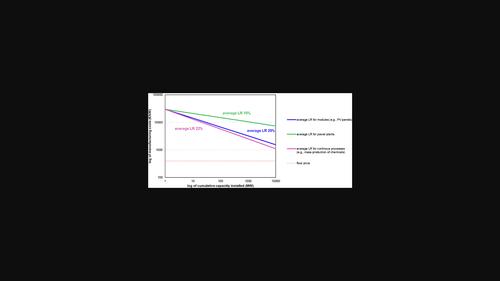Technological learning: Lessons learned on energy technologies
IF 5.4
3区 工程技术
Q2 ENERGY & FUELS
引用次数: 0
Abstract
The concept of technological learning is a method to anticipate the future development of the costs of technologies. It has been discussed since the 1930s as a tool for determining manufacturing cost reductions, starting in an airplane manufacturing plant, by means of learning curves and has been widely used since the 2000s in energy models to endogenize technological change. In this paper, the theoretical concept of technological learning based on energy technologies is analyzed based on examples from the literature. The main low‐carbon power generation technologies, photovoltaics, concentrated solar power, wind and nuclear energy were analyzed, showing different cost trends. Additionally, the impact of policy support on technological learning was discussed in concrete examples of bioethanol and heat pumps. We find that the homogeneity and the modularity of a technology are essential for high learning rates. A good proof is the manufacturing cost development of photovoltaics in recent decades, where a rather stable learning rate of 20% has been identified. On the contrary, nuclear power did not evolve into a homogeneous technology due to required environmental adaptations caused by accidents and the lack of standardization and application of new engineering approaches. In that case, the overall price further increased. Finally, another important condition is stable legal and regulatory conditions regarding the implementation.

技术学习:关于能源技术的经验教训
技术学习的概念是预测技术成本未来发展的一种方法。自20世纪30年代以来,它一直作为确定制造成本降低的工具进行讨论,从飞机制造工厂开始,通过学习曲线,自2000年代以来,它已被广泛用于能源模型中,以内因化技术变革。本文结合文献实例,分析了基于能源技术的技术学习的理论概念。对主要的低碳发电技术——光伏发电、聚光太阳能发电、风能发电和核能发电进行了分析,得出了不同的成本趋势。此外,以生物乙醇和热泵的具体例子讨论了政策支持对技术学习的影响。我们发现,技术的同质性和模块化对于高学习率至关重要。近几十年来光伏发电的制造成本发展就是一个很好的证明,其中已经确定了相当稳定的20%学习率。相反,由于事故导致的环境适应,以及缺乏标准化和新工程方法的应用,核能并没有演变成一种同质化的技术。在这种情况下,整体价格进一步上涨。最后,另一个重要条件是稳定的执行法律和监管条件。
本文章由计算机程序翻译,如有差异,请以英文原文为准。
求助全文
约1分钟内获得全文
求助全文
来源期刊

Wiley Interdisciplinary Reviews-Energy and Environment
ENERGY & FUELS-
CiteScore
11.70
自引率
3.30%
发文量
42
期刊介绍:
Wiley Interdisciplinary Reviews: Energy and Environmentis a new type of review journal covering all aspects of energy technology, security and environmental impact.
Energy is one of the most critical resources for the welfare and prosperity of society. It also causes adverse environmental and societal effects, notably climate change which is the severest global problem in the modern age. Finding satisfactory solutions to the challenges ahead will need a linking of energy technology innovations, security, energy poverty, and environmental and climate impacts. The broad scope of energy issues demands collaboration between different disciplines of science and technology, and strong interaction between engineering, physical and life scientists, economists, sociologists and policy-makers.
 求助内容:
求助内容: 应助结果提醒方式:
应助结果提醒方式:


